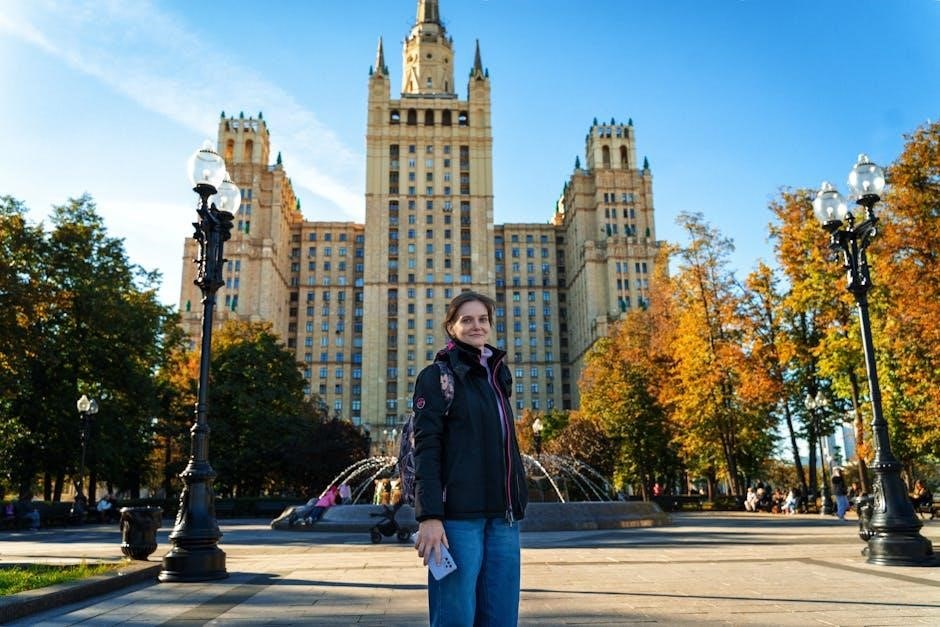
women’s jacket size guide
Discover the essential guide to understanding women’s jacket sizing. Learn how to determine your perfect fit, from measurements to styles, ensuring comfort and confidence in your choice.
1.1 Understanding the Importance of Proper Fit
A well-fitting jacket is essential for both comfort and style. Proper fit ensures freedom of movement and a flattering silhouette, boosting confidence. Incorrect sizing can lead to discomfort or an unflattering appearance. When shopping, especially online, accurate measurements are crucial. Consider fabric type, as stretch or rigid materials affect fit differently. Understanding your body shape and how jackets are designed for it helps in making the right choice. Common challenges include varying sizes across brands and styles, so relying on measurements rather than standard sizes is often more reliable. Taking the time to measure accurately ensures the best fit, whether for casual wear or formal occasions. Proper fit is key to enjoying your jacket fully.
1.2 Overview of Jacket Sizes and Measurements
Jacket sizes and measurements vary by brand and style, but they generally follow standardized guidelines. Sizes are typically based on body measurements like chest, shoulder, waist, sleeve length, and hip circumference. Understanding these measurements helps in selecting the right size. Key measurements include chest size, which is the most critical for jacket fit, and shoulder span, which determines the jacket’s shoulder fit. Waist and hip measurements are crucial for tailored or fitted jackets. Sleeve length, measured from the shoulder to the wrist, ensures proper arm fit. Brands often provide size charts, but variations exist, so comparing measurements across brands is essential. Accurate measurements ensure a comfortable and flattering fit, making the jacket suitable for its intended purpose.
Key Measurements for Women’s Jackets

Key measurements for women’s jackets include chest, shoulder, waist, sleeve length, and hip. These measurements ensure proper fit and comfort, essential for any jacket style.
2.1 Chest Measurement: How to Measure Accurately

To measure your chest accurately for a women’s jacket, wrap a flexible tape measure around the fullest part of your bust. Keep the tape level and parallel to the floor, ensuring it’s not too tight or loose. The measurement should be taken while standing straight, with your arms relaxed by your sides. If you’re wearing undergarments, ensure they are smooth and not compressing your chest. For the most accurate fit, measure over the clothes you plan to wear under the jacket. Record the measurement in inches or centimeters, as this will determine your jacket size. Accurate chest measurement ensures the jacket fits comfortably and looks flattering.
2.2 Shoulder Measurement: Identifying the Fullest Part
Measuring your shoulder span accurately is crucial for a well-fitting jacket. Stand straight and place the tape measure across the back, starting from the tip of one shoulder and ending at the tip of the other. Keep the tape measure level and parallel to the floor, ensuring it’s not too tight or loose. The measurement should reflect the natural width of your shoulders. For the most accurate result, wear a lightweight top, like a t-shirt, and keep your arms relaxed. This measurement helps determine how the jacket will sit on your frame, ensuring a balanced and comfortable fit. Accurate shoulder measurement is essential for proper jacket alignment and comfort.
2.3 Waist Measurement: Finding Your Natural Waistline
To measure your waist accurately, locate your natural waistline, which is the narrowest part of your torso. Stand straight and wrap a flexible tape measure around your body, keeping it level and parallel to the floor. The tape should sit just above your hipbone and below your ribcage, typically around the belly button area. Ensure the tape is snug but not tight, and avoid holding your breath or altering your posture. This measurement is essential for determining the jacket’s fit around your midsection. For the most accurate result, wear a lightweight top that lies flat against your skin. Proper waist measurement ensures the jacket sits comfortably and complements your body shape. Accurate sizing enhances both comfort and style.
2.4 Sleeve Length: Measuring from Shoulder to Wrist

To measure sleeve length accurately, start from the base of your neck, directly above the shoulder joint. Place the tape measure at this point and extend it down the back of your arm, following the natural curve to your wrist. Keep your arm slightly bent for a natural fit. The tape should lie flat against your skin, avoiding any twisting or pulling. For jackets, sleeve length typically ends just above the wrist bone. Ensure you’re wearing a lightweight shirt to get an accurate reading. Proper sleeve length ensures comfort and style, preventing sleeves from being too short or overly long. This measurement is crucial for achieving the perfect fit in your jacket. Accurate sizing ensures optimal comfort and a flattering appearance.
2.5 Hip Measurement: Measuring the Widest Point
To measure your hip circumference accurately, stand upright and relax your stance. Locate the widest part of your hips, typically 7-9 inches (18-23 cm) below your natural waistline. Wrap the tape measure around this area, ensuring it is parallel to the floor and not too tight or too loose. The measurement should encompass the fullest part of your hips and buttocks. This measurement is essential for determining how the jacket will fit around your lower torso. For jackets, the hip measurement helps ensure the garment sits comfortably and isn’t restrictive. Accurate hip sizing also ensures the jacket flatters your silhouette, providing a balanced fit. Proper alignment and a relaxed posture are key for precise results.

Understanding Jacket Fit Types
Jacket fit types vary to cater to different styles and preferences. Slim fit jackets are tailored close to the body for a modern look. Regular fit offers balanced comfort, while oversized fit provides a loose, casual style. Each fit type serves unique purposes, ensuring comfort and aesthetics. Understanding these differences helps in selecting the most flattering jacket for your body type. Proper fit enhances both functionality and fashion, making it crucial for a perfect jacket choice.
3.1 Slim Fit: Designed for a Close, Tailored Look
A slim fit jacket is crafted for a sleek, modern aesthetic, hugging the body closely to create a streamlined silhouette. Designed for those who prefer a tailored appearance, it skims over the torso without restricting movement. Ideal for petites or individuals with an hourglass figure, this fit emphasizes a polished, fashionable look. Fabrics with stretch or lightweight materials enhance comfort while maintaining structure. Pairing well with fitted dresses or high-waisted jeans, slim fit jackets are versatile for both casual and formal settings. They are perfect for creating a chic, put-together ensemble, ensuring a flattering fit that complements the wearer’s contours; This style is great for accentuating curves while maintaining sophistication.
3.2 Regular Fit: Balanced for Comfort and Style
A regular fit jacket offers a balanced blend of comfort and style, designed to sit comfortably on the body without feeling too tight or restrictive. Unlike slim-fit jackets, regular fit allows for a bit more room in the chest and shoulders, ensuring ease of movement. This fit is ideal for everyday wear, as it provides a classic, timeless look that flatters most body types. Regular fit jackets are versatile, pairing well with casual outfits like jeans and t-shirts or layered over dresses for a polished appearance. They strike the perfect balance between structure and relaxation, making them a practical choice for a variety of occasions.
3.3 Oversized Fit: Loose and Comfortable
An oversized fit jacket is designed to be loose and comfortable, offering a relaxed silhouette that prioritizes ease and style. This fit is characterized by a roomy chest, broad shoulders, and a longer length, creating a cozy, laid-back look. Oversized jackets often feature dropped shoulders and a boxy shape, making them perfect for layering over sweaters or dresses. They are a popular choice for casual outings and can easily be dressed up or down. The oversized fit is ideal for those who value comfort and want a trendy, versatile option. It suits a variety of body types and allows for freedom of movement while maintaining a fashionable appeal.
How to Measure Yourself for a Jacket
Accurately measure your chest, shoulders, waist, sleeve length, and hips using a flexible tape measure to ensure the best fit for your jacket.
4.1 Preparing for Measurements: What You Need
To ensure accurate measurements, gather a flexible tape measure, a pencil, and paper for recording. Wear a form-fitting top to measure over, as loose clothing can distort results. Stand in front of a mirror to maintain proper posture and visibility. Keep the tape measure level and parallel to the floor for consistency. Avoid measuring over bulky items like sweaters, as this can add unnecessary inches. If possible, have someone assist you to ensure accuracy, especially when measuring your back or shoulders. Good lighting and a clear workspace will help you stay focused and precise during the process.
4.2 Measuring Your Chest Size
To measure your chest size accurately, wrap the tape measure around the fullest part of your bust, keeping it level and parallel to the floor. Stand up straight and relax your shoulders to ensure the tape isn’t too tight or too loose. The tape should pass under your armpits and across the center of your bust. If you’re wearing a bra, ensure it’s snug but not compressing your bust. Take note of the measurement where the tape overlaps. For the most accurate result, measure twice and take the average. This measurement is crucial for determining your jacket size, as it ensures the best fit across the chest and shoulders.
4.3 Measuring Your Shoulder Span
To measure your shoulder span accurately, use a flexible tape measure. Stand up straight and place the tape at the back of your shoulders, aligning it with the highest points of your shoulder blades. The tape should be level and parallel to the floor, extending from one shoulder tip to the other. If measuring yourself, ensure the tape isn’t twisted and remains straight across your back. For assistance, have someone else wrap the tape around your back, keeping it snug but not tight. Record the measurement where the tape overlaps. This ensures the jacket’s shoulders fit correctly, providing a comfortable and flattering silhouette.
4.4 Measuring Your Waist Circumference
To measure your waist circumference accurately, locate your natural waistline, which is the narrowest part of your torso, typically just above your navel. Wrap a flexible tape measure around this area, ensuring it’s level and parallel to the floor. Stand up straight and relax your stomach muscles. The tape should be snug but not tight or constricting; Record the measurement where the tape overlaps. This measurement is crucial for determining the fit of jackets that have a defined waist, such as blazers or fitted styles. For jackets without a waist, this measurement helps ensure a balanced fit across your midsection for comfort and style.
4.5 Measuring Sleeve Length
To measure your sleeve length accurately, start with your arm slightly bent and relaxed by your side. Place the tape measure at the center back of your neck, just below the base of your skull. Slide the tape down over your shoulder, following the natural curve of your arm, and stop at your wrist. Ensure the tape is straight and not twisted. This measurement determines the sleeve length of your jacket, ensuring it fits comfortably from shoulder to wrist. For a more precise fit, consider whether you prefer sleeves slightly longer or shorter based on your personal style or the jacket’s design. Accurate sleeve length ensures optimal comfort and functionality, especially for active use.
4.6 Measuring Your Hip Circumference
To measure your hip circumference accurately, stand upright and place the tape measure around the widest part of your hips. This is typically 7-9 inches (18-23 cm) below your natural waistline. Ensure the tape is level and parallel to the floor, with the measure neither too tight nor too loose. This measurement is crucial for determining how the jacket will fit around your hips, especially for styles that are tailored or fitted. For the most accurate result, avoid pulling the tape taut or holding it too slack. Your hip measurement helps ensure the jacket complements your body shape, whether you have an hourglass, pear, or athletic build. This step is essential for achieving the perfect fit and comfort in your jacket choice. Always measure in front of a mirror to maintain proper alignment and accuracy.

Women’s Jacket Size Charts
Women’s jacket size charts provide a standardized guide to help determine the best fit based on body measurements. These charts typically include numerical or alphabetical sizes, correlating chest, waist, and hip measurements to specific sizes. They often cater to different body types and styles, ensuring a tailored fit. By referencing these charts, shoppers can navigate size variations across brands and styles, making the selection process easier and more accurate. Understanding size charts is essential for choosing a jacket that flatters your figure and meets your comfort preferences.
5.1 Standard Size Charts: Understanding the Numbers
Standard size charts for women’s jackets are designed to simplify the process of finding the perfect fit. These charts typically organize sizes numerically, such as 2, 4, 6, etc., and correspond to specific body measurements like chest, waist, and hip circumferences. By aligning your measurements with the chart, you can determine your ideal jacket size. Accurate measurements are crucial for ensuring comfort and style, as ill-fitting jackets can be uncomfortable and unflattering. While there may be slight variations between brands, adhering to a standard size chart provides a reliable starting point. Always refer to the specific chart provided by the brand to ensure the best fit for your body type.
5.2 International Size Differences: US, UK, EU
Women’s jacket sizes vary significantly across regions, with distinct standards in the US, UK, and EU. US sizes are typically numbered, while UK sizes often align closely with US measurements but may differ slightly in fit. EU sizes are based on body measurements in centimeters, offering a more direct correlation to actual body dimensions. These differences can lead to confusion when shopping internationally. For example, a US size 8 may equate to a UK size 12 or an EU size 38. Always refer to the specific size chart provided by the brand, as variations can occur between regions and brands. When purchasing from international retailers, consider the fit you prefer and double-check measurements to ensure the best fit.
Fabric type and jacket style can also influence how sizes translate across regions. For instance, a tailored blazer in EU sizes might fit differently than a similar style in US sizes. To avoid discrepancies, compare your measurements to the brand’s chart and consider factors like stretch or fabric thickness. If unsure, opt for a size that aligns with your body measurements rather than relying solely on numeric labels. This approach ensures a more accurate fit, regardless of regional sizing standards.

Fabric and Fit Considerations
Fabric choice significantly impacts jacket fit. Wool and denim offer structure, while leather provides a sleek look. Stretch fabrics enhance comfort without sacrificing shape, ensuring optimal mobility and style.
6.1 How Fabric Type Affects Fit
The fabric type significantly influences how a jacket fits. Stretchy fabrics, like spandex blends, provide flexibility and can fit closely without feeling restrictive. Non-stretch fabrics, such as cotton or polyester, require precise measurements for a comfortable fit. Thicker fabrics, like wool or leather, may feel tighter due to their weight and should be considered when choosing a size. Understanding the fabric’s drape and elasticity is essential for ensuring the jacket moves naturally with your body. For example, a leather jacket may need a slightly looser fit to accommodate its stiffness, while a denim jacket can fit snugly due to its structure. Always consider fabric type when selecting your size to achieve the best fit.
6.2 Stretch and Flexibility in Jackets
Stretch and flexibility in women’s jackets are crucial for both comfort and mobility. Fabrics like spandex, elastane, or stretch denim allow the jacket to move with the body, making it ideal for active lifestyles orLayering over bulky clothing. Jackets with stretch often provide a more forgiving fit, accommodating different body types and ensuring ease of movement. However, excessive stretch can compromise structure, so it’s essential to balance flexibility with stability. When choosing a stretch jacket, consider activities and the level of mobility needed. Proper fit ensures the jacket doesn’t stretch out of shape while maintaining its tailored appearance. This blend of comfort and style makes stretch jackets versatile for various occasions.

Common Jacket Styles and Their Sizing
Common jacket styles vary in fit and sizing, requiring specific measurements for accuracy. Bomber, parka, blazer, denim, and leather jackets each have unique fit characteristics.
- Bomber jackets: Slim-fit designs with a focus on chest and shoulder measurements.
- Parka jackets: Longer lengths may need hip and waist adjustments.
- Blazer jackets: Tailored fits emphasize precise shoulder and chest sizing.
- Denim jackets: Classic fits often allow for a relaxed silhouette.
- Leather jackets: Body type variations influence sizing for optimal comfort.
7.1 Bomber Jackets: Fit and Measurement Tips
Bomber jackets are designed for a relaxed, sporty fit, typically sitting just above the hip. To ensure the best fit, measure your chest and natural waistline, as bomber jackets are often slightly fitted around these areas. The sleeve length should reach your wrist for a streamlined look. Consider the jacket’s fabric; stretchy materials offer more flexibility. When choosing a size, ensure there’s enough room for layering without feeling restrictive. Pay attention to the jacket’s length, as some styles may be longer than others. Always check the size chart and reviews for specific brands, as sizing can vary. Proper measurements ensure a flattering, comfortable fit.

7.2 Parka Jackets: Longer Length and Sizing
Parka jackets are designed for durability and warmth, often featuring longer lengths and insulated designs. When sizing, consider the jacket’s intended use, as some parkas are tailored for outdoor activities. Measure your chest, waist, and hips to ensure a comfortable fit. The longer length typically extends past the hips, so check the jacket’s length against your body. Adjustable hems and cuffs can help customize the fit. If layering thick sweaters underneath, opt for a slightly larger size. Pay attention to sleeve length, ensuring it reaches your wrist when arms are slightly bent. Parkas often have a relaxed fit, but slim-fit options are available for a more tailored look.
7.3 Blazer Jackets: Tailored Fit Guidelines
Blazer jackets are designed to provide a polished, professional look, making proper fit essential. The jacket should skim your body without feeling tight, allowing ease of movement. The shoulders should align perfectly with yours, avoiding any slouching or tightness. For a tailored fit, the blazer should button smoothly across the chest without gaping or strain. The length should hit just below the hip for a balanced silhouette. When choosing a size, consider the fabric—wool or cashmere blazers may have less stretch than others. Ensure the sleeves hit the wrist bone for a streamlined appearance. A well-fitted blazer enhances posture and creates a sharp, put-together look.
7.4 Denim Jackets: Classic Fit and Measurements
Denim jackets are a timeless wardrobe staple, offering a classic fit that balances comfort and style. To ensure the best fit, measure your chest, waist, and sleeve length. The chest measurement should allow for a relaxed fit, typically 2-4 inches larger than your body measurement. The waist should align with your natural waistline, providing a defined shape without being restrictive. Sleeve length should reach just past your wrist bone for a classic look. For petites, consider shorter lengths, while taller frames may opt for longer styles. Check size charts for specific measurements, and if possible, try the jacket on to confirm the fit suits your body type.

7.5 Leather Jackets: Fitting for Different Body Types
Leather jackets can vary in fit depending on body type and style. For petite frames, look for cropped or fitted leather jackets to avoid overwhelming the silhouette. Hourglass figures can accentuate their curves with jackets that cinch at the waist. Pear-shaped women may prefer jackets with detailing that draws the eye upward, balancing the hips. Rectangular body types can opt for asymmetrical or zip-front styles to add shape. Consider the jacket’s stretch and how it fits when buttoned or zipped; Ensuring the shoulders fit well is key, as ill-fitting shoulders can throw off the entire look. Balance style with comfort for the perfect leather jacket fit.
Troubleshooting Common Sizing Issues
Addressing fit concerns ensures optimal comfort and style. Common issues include sizing inconsistencies, body type variations, and fabric differences. Solutions involve resizing, altering, or rechecking measurements for accuracy.
- If between sizes, choose based on desired fit tightness.
- Consider body type adjustments for tailored or relaxed fits.
- Fabric stretch impacts sizing; opt for styles suited to your needs.
- Trust measurements over size labels for best results.
8.1 What to Do If You’re Between Sizes
If you find yourself between sizes, it’s essential to consider your personal comfort and the jacket’s intended use. For example, if you prefer a snug fit, opt for the smaller size. If you want a more relaxed look, choose the larger size. Consider the fabric type, as stretchy materials like knits may offer more flexibility. Additionally, think about how you’ll layer the jacket—thicker layers may require a slightly larger size. If unsure, some brands allow for exchanges or returns, so you can try both sizes. Always refer back to the size chart and your measurements to make the best decision.
8.2 Adjusting for Body Type Variations
Understanding your body type is crucial for selecting the right jacket size. For petite women, focus on proportionate sizing to avoid overwhelming the frame. Tall individuals should opt for jackets with longer sleeves and torso lengths. Pear-shaped bodies benefit from jackets that cinch at the waist, creating balance. Hourglass figures can accentuate curves with tailored styles, while rectangular body types may prefer jackets with defined shoulders for added shape. Consider layering needs and personal comfort when adjusting sizes. Always refer to size charts and fabric stretch to ensure the best fit for your unique silhouette. Accurate measurements and style choices ensure a flattering and comfortable jacket fit.
Understanding your measurements and jacket fit is key to finding the perfect jacket. Accurate sizing ensures comfort and confidence, making every outfit effortlessly stylish and polished.
9.1 Final Tips for Choosing the Right Jacket Size
Choosing the right jacket size involves a combination of accurate measurements and personal preference. Always refer to the size chart provided by the manufacturer, as sizing can vary between brands. If you’re still unsure, consider trying the jacket on or opting for a size that aligns with your most frequent purchases. Pay attention to fabric type, as stretchy materials may allow for a snugger fit, while rigid fabrics require more room. Ensure sleeves reach your wrist and shoulders fit comfortably without strain. Lastly, don’t hesitate to seek assistance from a sales associate or use online size guides for the best fit.
9.2 Importance of Accurate Measurements
Accurate measurements are the cornerstone of finding the perfect jacket fit. Taking the time to measure correctly ensures comfort, style, and functionality. Ill-fitting jackets can restrict movement or appear unflattering, while precise measurements guarantee a tailored look. For online shoppers, accurate measurements are crucial for reducing returns and exchanges. They also help in selecting styles that flatter your body type, whether you prefer slim-fit, oversized, or anything in between. By prioritizing precise measurements, you can confidently choose jackets that enhance your appearance and provide the best fit for your lifestyle and preferences. This step is essential for a seamless and satisfying shopping experience.
Leave a Reply
You must be logged in to post a comment.